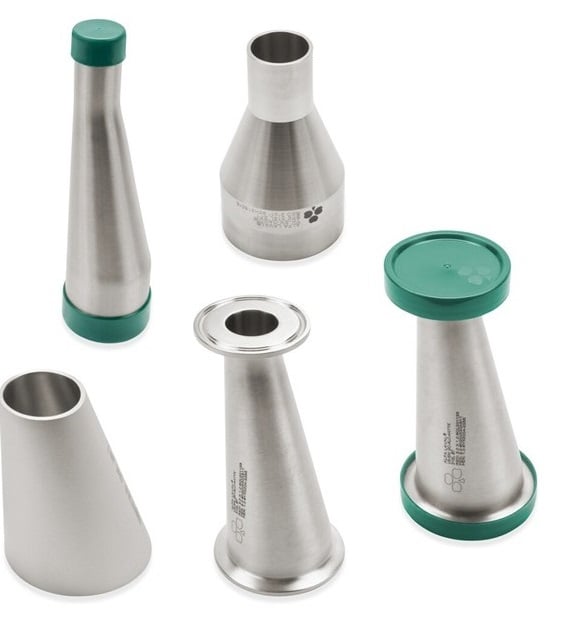EN 1.4404 / AISI 316L
Alfa Laval fluid handling equipment comply with the highest global manufacturing standards. Alfa Laval tubes and fittings made from AISI316L stainless steel meet this accreditation, offering outstanding quality. Alfa Laval tubes and fittings ensure uptime, safety, reliability and efficiency for duties across the dairy, food, beverage, home & personal care, biotech and pharmaceutical industries.

Stainless steel type EN 1.4404, also known as grade AISI 316L, is a specification of austenitic stainless steel with superior corrosion-resistance properties. It is a low carbon alternative to AISI 316. Although these two specifications share many similar qualities and properties, AISI 316L is softer and more flexible, and offers higher levels of corrosion resistance than AISI 316.
The difference in carbon content between AISI 316 and 316L means that both specifications have different strengths and usage. AISI 316L is widely used in the pharmaceutical industry due to its superior durability when welded and high levels of resistance to corrosive chemicals, such as acids and chlorides. AISI 316 is a popular choice in chloride environments due to its strength and resistance to pitting.
Its superior performance when exposed to chemical solutions makes AISI 316L stainless steel a reliable, high-spec choice for components in several environments, including biotechnical applications and pharmaceutical tubes and fittings.
Contact us
For any enquiry, please contact us. Our Customer Care team will be able to best answer you.
Did you know that tubes and fittings make up 90% of the fluid’s surface contact throughout the process flow?
Watch the animation and learn how tubes and fittings are the vital backbone of any process line.

Find the products you are looking for
The digital Alfa Laval Product Catalogue makes it easy to find and select the products you need. When you request a quote, the catalogue will list Alfa Laval’s partners in your region – and you can send your request directly.
EN 1.4404 / AISI316L material properties
Grade 316 and 316L stainless steel are higher-spec versions of 304 and 304L, with the addition of molybdenum and a slightly higher nickel content. This slight change to the composition gives AISI316 grade stainless steel increased corrosion resistance in many aggressive environments, such as contact with chemicals and salt water. The presence of molybdenum makes 316L stainless steel more resistant to pitting and crevice corrosion in fluids including those containing chlorides, such as sea water and acetic acid vapors.
EN 1.4404 stainless steel is a medical-grade stainless steel, making it ideal for use in chemical and pharmaceutical applications. Stainless steel components made from AISI 316L are also widely used in the food industry because of the chromium-nickel composition and high corrosion resistance levels, making it a superior choice.
When compared to AISI 316, AISI 316L stainless steel is less rigid, less ductile and has a lower tensile strength.
Coastal environments using EN 1.4404 / AISI316L
EN 1.4404 / AISI316L stainless steel is reliable and durable when exposed to or submerged in water and other fluids. 316L grade stainless steel is particularly suitable for use in coastal environments, due to its superior durability when in contact with salt water.
As is standard for all stainless steel products, regular contact with acids may gradually cause wear to AISI316L stainless steel fixtures.
Corrosion resistance of EN 1.4404 / AISI316L
1.4404 / AISI 316L stainless steel is superior to 304L in terms of corrosion resistance and offers high levels of durability as it can withstand exposure to chloride solutions and acids. The corrosion resistance properties of 316L stainless steel can be improved further with surface treatments. Please contact Alfa Laval if you have any questions about improving surfaces.
Cold working with EN 1.4404 / AISI316L
Cold working in stainless steel refers to the process of forming the material into the desired shape of the fitting. The cold working also strengthen and hardens the material. This process can occur at room temperature or slightly above, hence the term "cold" working. Cold working is a versatile method used in various applications where increased strength and precise dimensions of stainless steel are desired.
Cold working creates tensions in the material which can be removed by annealing. This stainless steel grade has a very low magnetizability and is suitable for cold-working.
Weldability
Stainless steel 316L is highly weldable and is commonly used in TIG welding. AISI 316L stainless steel is superior to AISI 316 in weldability as the higher carbon grade is far more vulnerable to weld decay. AISI 316L can be welded easily and effectively with steel as well as with other metals.
Aesthetic appeal and polishing
In addition to its functional properties, EN 1.4404 also has aesthetic appeal. It can easily be polished to a high gloss, making it more aesthetic.
EN 1.4307 (304L) versus EN 1.4404 (316L)
While both are low-carbon, austenitic stainless steel, EN 1.4404 has superior corrosion resistance due to its molybdenum content. EN 1.4307 (304L) is more vulnerable to corrosion in chloride environments.
EN 1.4401 (316) versus EN 1.4404 (316L)
The main difference between these two grades lies in their carbon content. EN 1.4401 contains more carbon, making it less preferable for welding due to the risk of carbide precipitation, while EN 1.4404 offers better welding properties due to its lower carbon content.
EN 1.4404 /AISI316L stands out in the world of stainless steel with its exceptional corrosion resistance, weldability, and strength. Its low carbon content, coupled with good formability and aesthetic appeal, makes it a versatile material suitable for a wide range of applications. These attributes, along with its hygienic properties and non-magnetic nature, make it a preferred choice in industries like food, beverage, pharmaceuticals, and biotechnology. As industries evolve, the demand for materials that can withstand harsh environments while maintaining integrity and appearance is on the rise, and EN 1.4404-AISI316L fits this perfectly.
EN 1.4404 versus AISI 316L
In practice, for many applications, EN 1.4404 and AISI 316L are considered interchangeable.
The differences between the standard EN 1.4404 and AISI 316L primarily lie in the way these standards are defined and the regions where they are predominantly used. Both standards refer to a similar type of stainless steel, known for its excellent corrosion resistance and good mechanical properties.
EN 1.4404: This is the European standard, defined by the European Committee for Standardization. It is commonly used and recognized in European countries.
AISI 316L: The American Iron and Steel Institute (AISI) standard, predominantly used in the United States and other countries where American standards are followed.
While both EN 1.4404 and AISI 316L stainless steels are similar in terms of their chemical composition (mainly iron, chromium, nickel, and molybdenum), there are slight differences in the maximum and minimum percentages allowed for these elements.
These differences, although minor, can affect the steel's performance in various applications, especially in terms of corrosion resistance, strength, and ability to be welded or formed.
Please be aware of that components that use these materials might need to adhere to the specific certification or compliance requirements as dictated by the standard. This can be crucial in industries where material specifications are strictly regulated, like in the hygienic industries.
Chemical compositions EN 1.4404 / AISI 316L
|
Chemical element |
EN 1.4404 percent |
AISI 316L percent |
|
Chromium (Cr) |
16.50 – 18.50 | 16.00 – 18.00 |
|
Nickel (Ni) |
10.00 – 13.00 | 10.00 – 14.00 |
|
Manganese (Mn) |
0.00 – 2.00 | 0.00 – 2.00 |
|
Silicon (Si) |
0.00 – 1.00 | 0.00 – 0,75 |
|
Phosphorous (P) |
0.00 – 0.045 | 0.00 – 0.045 |
|
Sulphur (S) |
0.00 – 0.03 | 0.00 – 0.03 |
|
Carbon (C) |
0.00 – 0.015 | 0.00 - 0,03 |
|
Iron(Fe) |
62,80 – 71.5 |
62.00 – 72.00 |
|
Molybdenum (Mo) |
2.00 – 2.50 |
2.00 – 3.00 |
|
Nitrogen (N) |
0.00 – 0.11 | 0.00 – 0.11 |
Physical properties EN 1.4404 / AISI 316L
|
Property |
Value EN 1.4404 |
Value AISI 316L |
| Melting point (Solidus) | 1400 °C | 1380 °C |
|
Density |
7.90 g/cm3 | 7.90 g/cm3 |
|
Thermal conductivity |
15 W/m-k | 15 W/m-k |
|
Thermal expansion |
15.9x10-6/K | 15.9x10-6/K |
|
Electrical Conductivity: Equal Volume |
2.3 % IACS | 2.3 % IACS |
|
Modulus of elasticity (Young’s Tensile) |
200 GPa | 200 GPa |
Mechanical properties EN 1.4404 / AISI 316L
|
Property |
Value EN 1.4404 |
Value AISI 316L |
| Proof stress | 200 Min MPa | 200 Min MPa |
|
Tensile strength, Ultimate (UTS) |
600 – 900 MPa | 530 – 1160 MPa |
|
Elongation at break |
14 – 43 % | 9 – 50% |
|
Hardness, Brinell |
190 – 270 | 170 - 350 |
Tubes and fittings – The vital backbone of hygienic processes
The importance of tubes and fittings in hygienic production cannot be overstated. Connecting all processing equipment, they safeguard the reliability, efficiency, safety and sustainability of the process flow.
Superior safety
Designed for unique cleanability and full traceability to safeguard the integrity of processes and products.
Unmatched reliability
Exceptional quality, durability, and longevity to ensure high uptime and productivity.
Optimum efficiency
Engineered for seamless flow and easy cleaning, assuring optimized processes and increased yield.
Sustainability at heart
Manufactured and delivered with sustainability in mind, reducing the carbon footprint and meeting sustainability targets.
